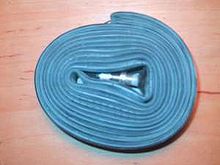Ban pit


Ban pit iku sawijining ban sing dipasang ing rodha sawijining pit, pit rodha tunggal, pit rodha telu, pit rodha papat, lan jinis pit liyané. Kadhangkala ban iki uga dianggo ing kursi rodha. Ban pit iku wigati banget tumrap empuké utawa suspènsi nalia numpak pit.
Ban pit modhèren bisa diklasifikasi miturut sawatara kritéria:
- miturut cara nèmpèlé ing pèleg: clincher utawa tubular,
- cara panyimpenan hawa: tabung, tanpa tabung (tanpa ban njero) utawa padhet/dholog,
- Jinis benang: slick utawa knobby.
Paramèter[besut | besut sumber]
Ukuran[besut | besut sumber]
Ukuran ban modhèren (kaya "37-622", uga kaloka minangka ETRTO) diatur nganggo baku internasional ISO 5775, bebarengan karo baku ukuran rodha pit (tuladha "622×19C"). Older English (inch, e.g. "28×1-5/8×1-3/8") and French (metric, e.g. "700x35C") designations are also still used, but can be ambiguous. The diameter of the tire must match the diameter of the rim, but the width of the tire only has to be in the range of widths appropriate for the width of the rim.[1] Diameters vary from a large 910 mm, for touring unicycles, to a small 125 mm, for roller skiing.[2] Widths vary from a narrow 18 mm to a wide 119 mm for the Surly Big Fat Larry.[3]
Tekanan ban[besut | besut sumber]
Tekanan ban pit wiwit saka sangisoré 30 psi (2 bar; 207 kPa) tumrap ban njero pit gunung (tubeless)[4] nganti 220 psi (15 bar; 1,517 kPa) tumrap ban pit balap.[5] The pressure rating of tires is usually stamped somewhere on the sidewall. It may be indicated as "Maximum Pressure," or "Inflate to... " and is usually expressed as a range (for example, "90–120 psi or 6.2–8.3 bar or 620–830 kPa". Inflating to the lower number in the pressure range will tend to increase traction and make the ride more comfortable. Inflating to the higher number will tend to make the ride more efficient and will decrease the chances of getting a flat tire.[6]
One published guideline for clincher inflation pressure is to pick the value for each wheel that produces a 15% reduction in the distance between that wheel rim and the ground between loaded (i.e. with the rider) and unloaded. Pressures below this lead to increased rolling resistance and likelihood of pinch-flats. Pressures above this lead to less rolling resistance in the tire itself, but to larger energy losses in the frame and rider.[7] Bicycle tires are essentially thin-walled pressure vessels and so the circumferential force in the casing is directly proportional to the internal pressure and to the tire diameter, and the force in the longitudinal direction is half of this.
Ban njero ora bener-bener anti bocor, lan kanthi alamiah bakal kempès baka sethithik. Ban njero saka butyl luwih anti bocor tinimbang saka bahan karè latèks.[8] At least one public bicycle sharing system, Bixi, is inflating tires with nitrogen, instead of simple air, which is already 78% nitrogen, in an attempt to keep the tires at the proper inflation pressure longer,[9] though the effectiveness of this is debatable.[10][11][12]
Pabrik[besut | besut sumber]
Pabrik ban pit sing misuwur antarané:
- Bontrager (owned by Trek)
- Cheng Shin Rubber (uga kanthi mèreks Maxxis lan CST)
- Coker Tire
- Continental
- Hutchinson
- Kenda
- Michelin
- Nokian
- Schwalbe
- Specialized Bicycle Components
- Vittoria
- Vredestein
- Wilderness Trail Bikes
Réferènsi[besut | besut sumber]
- ↑ Brown, Sheldon. "Tire sizing". Sheldon Brown. Dibukak ing 2010-06-13.
- ↑ Mike Muha (July 22, 2002). "The Perfect Rollerski? The V2 Aero 150S". A Michigan Nordic Ski Racer. Dibukak ing 2010-06-18.
- ↑ "Big Fat Larry". SurlyBikes.com. Dibukak ing 2012-04-26.
- ↑ Masalah sitiran: Tenger
<ref>ora trep; ora ana tèks tumrap refs kanthi jenengFelton - ↑ "Tire Pressure Instruction". Nimble. 1997. Dibukak ing 2010-06-14.
- ↑ Frank Berto (2006). "All About Tire Inflation" (PDF). Beach Cities Cycling Club. Diarsip saka sing asli (PDF) ing 2012-09-14. Dibukak ing 2012-08-06.
- ↑ Jan Heine (2006). "Optimizing Your Tire Pressure for Your Weight" (PDF). Bicycle Quarterly. Diarsip saka sing asli (PDF) ing 2010-03-31. Dibukak ing 2010-06-28.
- ↑ Brown, Sheldon. "Tube (inner)". Sheldon Brown. Dibukak ing 2010-06-29.
- ↑ Ross Lydall (2010-05-21). "Taking a ride on Boris's hot wheels hire bikes". London Evening Standard. Dibukak ing 2010-06-29.
- ↑ "Do Nitrogen-Filled Tires Enhance Fuel-Efficiency?". Scientific American. September 30, 2008. Dibukak ing 2010-06-29.
- ↑ Tom and Ray Magliozzi (February 2005). "Dear Tom and Ray". CarTalk.com. Dibukak ing 2010-06-29.
- ↑ Gene Petersen (Oct 4, 2007). "Tires - Nitrogen air loss study". Consumer Reports. Diarsip saka sing asli ing 2011-11-26. Dibukak ing 2011-12-10.
Bottom line: Overall, consumers can use nitrogen and might enjoy the slight improvement in air retention provided, but it's not a substitute for régulèr inflation checks.
Pranala njaba[besut | besut sumber]
| Wikimedia Commons duwé médhia ngenani Bicycle tires. |
